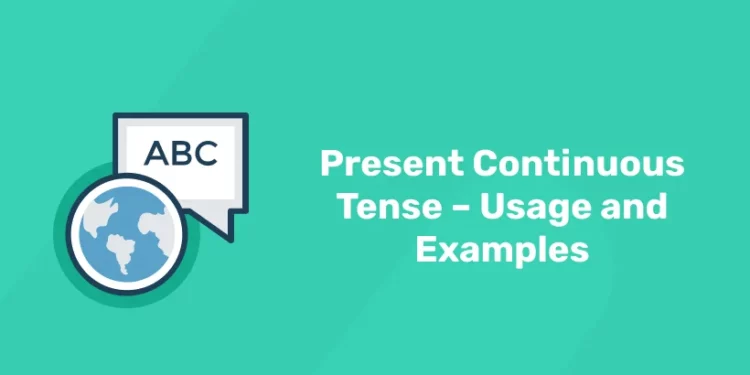Table of Contents
The present continuous (also called present progressive) is a verb tense which is used to show that an ongoing action is happening now, either at the moment of speech or now in a larger sense. The present continuous can also be used to show that an action is going to take place in the near future.
Elevate your speaking skills with our Spoken English Course!
What is Present Continuous Tense?
The present continuous tense is one which is commonly used within the English language and often uses the -ing form of a verb, for example ‘she is running.’ We can see that the sentence is happening continuously in the present moment.
The present continuous verb tense, also known as the present progressive, is used to describe an action that is currently happening or may happen in the future.
The present continuous tense is typically used for the following four general cases:
- To describe events that are happening at the current time
- To discuss an event that is temporary in nature, will continue into the future, but end at a particular time
- To list future plans
- To describe a new pattern or a habit
This verb tense is formed with a variant of the verb to be + the present participle (verb form ending in -ing). These verbs can also take adverb modifiers to talk about an activity that is continuing into some future time (e.g. in one hour’, this Fall’). Additionally, present continuous verb forms are most commonly going to be found in the wild using dynamic verbs’ that describe:
- an activity (e.g. learn, listen, read)
- a process (e.g. change, grow, shrink)
- a bodily sensation (e.g. ache, feel, hurt)
- a transitional event (e.g. arrive, leave)
- a momentary occurrence (e.g. hit, jump, kick).
In the next section are ten examples to demonstrate the various use cases described above. After that are several exercises to provide practice identifying the different forms of the present continuous verb tense. As always, a good way to continually reinforce this information is to try and identify this type of verb while reading and always, always, always keep a dictionary or google search window handy.
Present Continuous Tense – Formula
1: Which of the sentences below is grammatically correct?
Subject + am/is/are + present participle (verb+ing) + the rest of the sentence
However, there are other things to be aware of. You should also learn how sentences are constructed using the present tense of verbs when the verbs are positive, negative, interrogative, and negative interrogative.
Spoken English Course for Guaranteed Confidence and Career Growth
Spoken English Course by Entri App: Enhance your communication skills, gain certification, and boost your career with confidence.
Join Now!Using the Present Continuous Tense
We use the present continuous tense in the following situations:
- to talk about actions and situations in progress at the moment of speaking. For example,
I’m reading a book.
She’s having dinner now.
- to refer to an ongoing long-term action. It may not be happening in this precise moment, but it’s happening in this general period of time. For example,
They’re not working with us this year.
He’s studying Economics at university.
- to talk about a planned event in the near future. For example,
They’re meeting the clients next Monday.
She’s not working next week.
- to talk about situations that happen frequently and are annoying, usually combined with the adverb ‘always’. For example,
My brother is always leaving dirty clothes around the house.
Sally is always complaining about her job.
- to talk about changing situations. For example,
She’s getting better and better at English because she practices a lot.
The weather is getting much warmer.
How do we form the present continuous?
We form the present continuous with the auxiliary verb “be” and the present participle form of the main verb. For the auxiliary verb “be” we use its present forms am, are and is:
am/are/is + present participle
The present participle form of all verbs ends in “ing”, and to make it we normally simply need to add “ing” to the base form of the verb. There are some exceptions though:
| Verb | Rule | Example |
| Most verbs ending with consonant + “e” | take off the “e” | hoping; taking |
| Most verbs ending in consonant + vowel + consonant | double the last consonant | batting; referring; swimming |
| Verbs ending in consonant + vowel + consonant where the last consonant is “w”, “x” or “y” | don’t double the last consonant | blowing; flexing |
| Verbs ending in “ie” | change the “ie” to “y” | dying; lying |
| Verbs ending in “c” | add “k” | panicking |
Start speaking English like a native with our comprehensive course.
Affirmative sentences in the Present Continuous
To make affirmative sentences in the present continuous we use the subject followed by the appropriate form of the auxiliary verb ‘to be’ and the main verb in the -ing form.
Subject + am/is/are + verb +ing
Examples:
- I’m doing my homework.
- My sister’s sitting on the sofa.
- They’re riding their bikes.
Start speaking English like a native with our comprehensive course.
Negative sentences in the Present Continuous
To make negative sentences in the present continuous, we simply change the auxiliary verb ‘to be’ from positive to negative.
Subject + am/is/are not + verb +ing
Examples:
- I’m not doing my homework.
- My sister’s not sitting on the sofa.
- They’re not riding their bikes.
Questions in the Present Continuous
To make questions in the present continuous you invert the subject and the auxiliary verb ‘to be’. So the structure is:
Am/is/are + subject + verb +ing
Examples:
- Are you doing your homework?
- Is your sister sitting on the sofa?
- Are they riding their bikes?
Verbs NOT used in the Present Continuous
There are many verbs that cannot be used in the Present Continuous tense. These are verbs that are not actions but describe states or preferences. For these verbs we use the present simple. For example:
I’m hating you. WRONG
I hate you. CORRECT
He’s loving the cake. WRONG
He loves the cake. CORRECT
Here are examples of preference verbs that cannot be used in the present continuous tense:
- to love
- to like
- to hate
- to dislike
- to care
- to mind
- to want
- to wish
- to prefer
- to appreciate
Here are some state verbs that are also not used in the present continuous:
- to know
- to remember
- to understand
- to forget
This rule also applies to the five senses:
- to feel
- to hear
- to see
- to smell
- to taste
And with verbs that express an idea or belief:
- to think
- to suppose
- to believe
- to feel
- to doubt
- to assume
- to consider
Other verbs that are only used in the present simple tense are:
- to seem
- to look (resemble)
- to be
- to have (for possession)
Join our Spoken English program today and communicate with ease!
Spelling changes present continuous
Be careful as there are also some spelling changes:
Spelling: Verbs that end with one -e
For verbs that end with one -e, drop the -e and add -ing. Note that these verbs the -e sound at the end is silent. (e.g., believe, bake, take, love).
- believe — believing
- bake — baking
- love — loving
- take — taking
- choke — choking
- make — making
- have — having
But:
With verbs ending with a long -e sound, add -ing as normal:
- see — seeing
- be — being
- flee — fleeing
- agree — agreeing
Spelling: Short one-syllable verbs ending in CVC
If the verb has one syllable and ends with CVC(a consonant + vowel + consonant), we double the final consonant before adding the -ing ending:
- sit — sitting
- fit — fitting
- get — getting
- plan — planning
- run — running
- put — putting
- stop — stopping
- swim — swimming
Spelling: verbs ending in w, x and y
Notice these verbs end in CVC (consonant vowel consonant). However, do not double the consonant for verbs that end in w, x or y.
- throw — throwing
- blow — blowing
- show — showing
- play — playing
- flex — flexing
Spelling: Two or more syllable verbs
When verbs ending in ending in CVC (consonant vowel consonant) have two or more syllables, double the last consonant if the last syllable is stressed.
- begin — beginning (be / GIN = the last syllable is stressed)
- control — controlling (con / TROL = the last syllable is stressed)
- forget — forgetting
- upset — upsetting
- regret — regretting
- refer — referring
- commit — committing
However, when the last syllable is not stressed, just add -ing as usual.
- benefit — benefiting ( be / NE / fit = second syllable is stressed not the last)
- happen — happening (HAPP / en = first syllable is stressed not the last)
- open — opening
- listen — listening
- deliver — delivering
Spelling: Verbs ending in -ie
If a verb ends in -ie change ‘ie’ to ‘y’ then add -ing.
- die — dying
- lie — lying
- tie — tying










